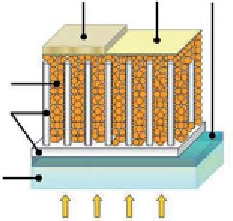Environmental Engineering Reference
In-Depth Information
ZnO nanowire; piezoelectric properties-based nanoenergy generator and
thermoelectric generator are possible devices.
16.6.1 Photovoltaic Applications
Zinc oxide is transparent for visible light and good electrical conduc-
tor; hence it can be used as an electrode for PV device fabrication [186].
Nanowire i lms provide the best geometry to enhance light trapping/
scattering to improve solar light absorption, which ultimately increases
the device ei ciency and performance. h e ZnO nanowire i lms are
also used as anti-rel ector in various conventional solar cells [188]. P-n
junction-based conversional solar cells are fabricated using ZnO as n-type
materials, but recently non-conventional device design has become more
popular. Excitonic solar cells are the most prominent due to their facile and
low-cost fabrication process, however, ei ciency and instability are exist-
ing issues. Dye-sensitized solar cells and organic-based hybrid solar cells
have demonstrated reasonably well in ei ciency, but stability of these solar
cells is a major issue [189]. Solid-state excitonic solar cells are an option
to get more stable device, but poor ei ciency is a problem here [190]. A
typical solid-state excitonic solar cell is demonstrated in Figure 16.9; ZnO
nanowire grown on ZnO seed layer works as high surface electrode to
collect the photogenerated electrons and PbSe quantum dots are used as
active material and absorber of sunlight, which generate electron-hole pair.
Due to the dif erence in chemical potential of top gold contact and bot-
tom ZnO/ITO contact, photogenerated carriers easily separated from each
Gold
α
-NPD
ITO
2.4
4.0
α
-NPD
4.3
PbSe
NCs
5.2
Pbse QDs
ZnO
4.8
5.1
Au
ITO
5.5
ZnO
NWs
Glass
7.7
(
a
)
(
b
)
Figure 16.9
(a) Schematics of a PbSe QD / ZnO nanowire solar cell and (b) band diagram
of device [190].


Search WWH ::

Custom Search